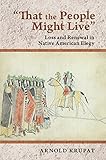"That the people might live" : loss and renewal in Native American elegy / Arnold Krupat.
Material type: TextPublisher: Ithaca : Cornell University Press, 2012Description: 1 online resource (xii, 242 pages) : illustrations, portraitsContent type:
TextPublisher: Ithaca : Cornell University Press, 2012Description: 1 online resource (xii, 242 pages) : illustrations, portraitsContent type: - text
- computer
- online resource
- 9780801465857
- 0801465850
- 9780801465857
- Indian literature -- United States -- History and criticism
- Folk literature, Indian -- History and criticism
- American literature -- Indian authors -- History and criticism
- Elegiac poetry, American -- Indian authors -- History and criticism
- Indians of North America -- Funeral customs and rites
- Loss (Psychology) in literature
- Death in literature
- Grief in literature
- Littérature populaire indienne d'Amérique -- Histoire et critique
- Littérature américaine -- Auteurs indiens d'Amérique -- Histoire et critique
- Perte (Psychologie) dans la littérature
- Mort dans la littérature
- Chagrin dans la littérature
- LITERARY CRITICISM -- Native American
- LITERARY CRITICISM -- American -- General
- American literature -- Indian authors
- Death in literature
- Folk literature, Indian
- Grief in literature
- Indian literature
- Indians of North America -- Funeral customs and rites
- Loss (Psychology) in literature
- United States
- 810.9897 23
- PM157
| Item type | Home library | Collection | Call number | Materials specified | Status | Date due | Barcode | |
|---|---|---|---|---|---|---|---|---|
 Electronic-Books
Electronic-Books
|
OPJGU Sonepat- Campus | E-Books EBSCO | Available |
Includes bibliographical references and index.
"Surveys the traditions of Native American elegiac expression over several centuries. Krupat covers a variety of oral performances of loss and renewal, including the Condolence Rites of the Iroquois and the memorial ceremony of the Tlingit people known as koo'eex, examining as well a number of Ghost Dance songs, which have been reinterpreted in culturally specific ways by many different tribal nations. Krupat treats elegiac "farewell" speeches of the eighteenth and nineteenth centuries in considerable detail, and comments on retrospective autobiographies by Black Hawk and Black Elk. Among contemporary Native writers, he looks at elegiac work by Linda Hogan, N. Scott Momaday, Gerald Vizenor, Sherman Alexie, Maurice Kenny, and Ralph Salisbury, among others. Despite differences of language and culture, he finds that death and loss are consistently felt by Native peoples both personally and socially: someone who had contributed to the People's well-being was now gone. Native American elegiac expression offered mourners consolation so that they might overcome their grief and renew their will to sustain communal life"-- Publisher's Web site.
List of Illustrations -- Acknowledgments -- Introduction -- 1. Oral Performances (i) -- The Iroquois Condolence Rites -- The Tlingit Koo. 'eex' -- Occasional Elegy -- Some Ghost Dance Songs as Elegy -- 2. Oral Performances (ii) -- "Logan's Lament" -- Black Hawk's "Surrender Speech" -- Chief Sealth's Farewell -- Two Farewells by Cochise -- The Surrender of Chief Joseph -- 3. Authors and Writers -- Black Hawk's Life -- Black Elk Speaks -- William Apess's Eulogy on King Philip -- The Elegiac Poetry of Jane Johnston Schoolcraft, John Rollin Ridge, and Others -- 4. Elegy in the "Native American Renaissance" and After -- Prose Elegy in Momaday, Hogan, and Vizenor -- Elegiac Poetry -- Appendix. Best Texts of the Speeches Considered in Chapter 2 -- Notes -- Works Cited -- Index.
In English.
eBooks on EBSCOhost EBSCO eBook Subscription Academic Collection - Worldwide
There are no comments on this title.

